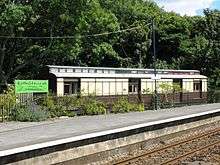Camping coach

Camping coaches were offered by many railway companies in the United Kingdom as accommodation for holiday makers in rural or coastal areas. The coaches were old passenger vehicles no longer suitable for use in trains, which were converted to provide basic sleeping and living space at static locations. Many of the coaches would be removed from their stations in the winter and overhauled at the railway's workshops ready to be returned in the spring, being placed on sidings. The local railway staff looked after the coaches as part of their duties.
The charges for the use of these coaches were designed to require groups of people to travel by train to the stations where they were situated; they were also encouraged to make use of the railway to travel around the area during their holiday.
History

They were first introduced by the London and North Eastern Railway in July 1933, when there was a great deal of popular enthusiasm in the urban population for hiking and camping as holiday activities. Initially ten vehicles were provided, chiefly at inland beauty spots.
The following year, two other railway companies followed suit: the London, Midland and Scottish Railway, with what it originally called "caravans", and the Great Western Railway which called them "camp coaches". In 1935 they were introduced on the Southern Railway and on the L.M.S. Northern Counties Committee in Northern Ireland. In the same year the L.N.E.R. introduced a touring camping coach.
As a result of World War II, the facility was not made available after the 1940 season and many of the vehicles were used as temporary accommodation for railway staff or others in connection with the war effort. The Southern Railway reintroduced coaches at some sites in 1947, but their large-scale return came under British Railways ownership in 1952. In 1960 some sites started to receive conversions from Pullman lounge cars. The sites at which larger numbers of coaches were located tended to be on the west coast including Abergele in North Wales, and, in Lancashire, Heysham (pre-war), Squires Gate in Blackpool, and Hest Bank.
The number of camping coaches offered for hire declined from the mid-1960s as other forms of holidays became more popular, the condition of the vehicles deteriorated, and the number of staffed stations at which they could be sited decreased. The last were offered to the public by the London Midland Region of British Railways in 1971, although some were retained for many years after this for railway staff to hire for their holidays at Dawlish Warren in Devon and Marazion in Cornwall.
A few heritage railways and private companies have now taken to offering camping coaches at select locations. While ideal for railway enthusiasts, they are also marketed to the general public. Privately owned cars serving a similar purpose may also be found, for example at North Conway on the Conway Scenic Railroad in the United States.
Current locations

- Bere Ferrers, Devon
- Blue Anchor, Somerset
- Cloughton, North Yorkshire
- Coalport, Shropshire
- Dawlish Warren, Devon
- Ebberston, Allerston, North Yorkshire
- Glenfinnan, Highland
- Goathland, North Yorkshire
- Hayle, Cornwall
- Levisham, North Yorkshire
- Petworth, West Sussex
- Ravenglass, Cumbria
- Rogart, Highland
- St Germans, Cornwall
Locations in 1957
This list shows the locations of camping coaches in a typical year - 1957 - but the locations used did vary over time.[1]
Eastern Region
6-berth coaches: Corton, Felixstowe Pier, Hopton, Lowestoft North, Mundesley, Oulton Broad South
North Eastern Region
4-berth coaches: Robin Hood's Bay, Scalby
6-berth coaches: Cloughton, Bolton Abbey, Goathland, Kettleness, Ravenscar, Sandsend, Sandsend (East Row), Stainton Dale, Staithes
Scottish Region
6-Berth coaches: Aboyne, Aberdour, Aberfeldy, Aberlady, Appin, Arisaig, Benderloch, Burghead, Carnoustie, Carr Bridge, Eddleston, Elie, Fairlie High, Fortrose, Glenfinnan, Gullane, Kentallen, Kingussie, Loch Awe, Lochmaben, Lundin Links, Monifieth, Morar, Plockton, Portressie, St Combs, St Monance, Strathyre, Strome Ferry, Tyndrum Lower, West Kilbride
Southern Region
6-berth coaches: Amberley, Bere Ferrers, Combpyne, Corfe Castle, East Budleigh, Hinton Admiral, Littleham, Lyndhurst Road, Martin Mill, Newton Poppleford, Sandling for Hythe, Sway, Tipton St John, Woodbury Road, Wool, Wrafton
London Midland Region
6-berth coaches: Aber, Abergele, Bakewell, Bassenthwaite Lake, Betws-y-Coed, Squires Gate (Blackpool), Coniston, Darley Dale, Glan Conway, Grange-over-Sands, Lakeside (Windermere), Llanberis, Rhuddlan, Seascale, Silloth
Western Region
8-berth coaches: Aberayron, Aberdovey, Abererch, Arthog, Barmouth Junction, Blue Anchor, Borth, Bow Street, Buckfastleigh, Carrog, Cheddar, Chudleigh, Congesbury, Dawlish Warren, Dolgelly, Duffryn Ardudwy, Fairbourne,[2] Ferryside, Fowey, Gara Bridge, Kerne Bridge, Lavernock, Limpley Stoke, Llwyngwril, Loddiswell, Lustleigh, Luxulyan, Manorbier, Marazion, Penally, Perranwell, Saundersfoot, St Agnes, St Erth, Shepherds, Shiplake, Stogumber, Sully, Symonds Yat, Talsarnau, Tintern, Wargrave, Winscombe, Yealmpton
References
- ↑ Camping Coaches 1957 Leaflet Publisher British Railways BR Ref 35028/1 No ISBN
- ↑ lindsaybridge. "1971 camping coach". Flikr. Retrieved 2017-02-07.
- McRae, Andrew (1997). British Railway Camping Coach Holidays: The 1930s and British Railways (London Midland Region). Scenes from the Past: 30 Part One. Foxline. ISBN 1-870119-48-7.
- McRae, Andrew (1998). British Railways Camping Coach Holidays: A Tour of Britain in the 1950s and 1960s. Scenes from the Past: 30 Part Two. Foxline. ISBN 1-870119-53-3.
- Fenton, Mike (1999). Camp Coach Holidays on the G.W.R. Wild Swan. ISBN 1-874103-53-4.
- Fenton, Mike (1996–2004). "The L.N.E.R. camping coach scheme". British Railway Journal.
- Camping Coaches 1957 Leaflet Publisher British Railways BR Ref 35028/1 No ISBN